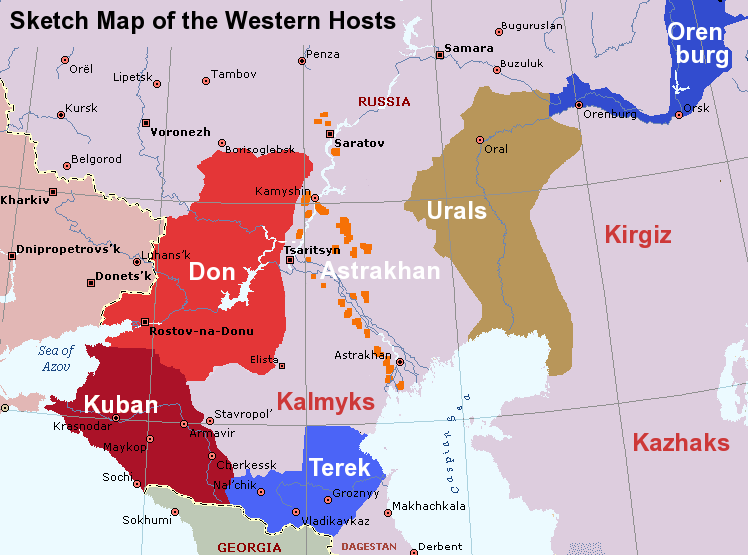
The Astrakhan Host in the Russian Civil War
The Astrakhan Cossacks had no unified Host area, instead having a selection of stanitsas and farms along the Volga from Saratov down.

Uniforms
The Astrakhan Host soldiers wore standard Cossack dress, with their distinguishing colour being yellow.
Astrakhan Cossack Cavalry
Kalmyks
Other troops
A Host Divided
The Astrakhan host was small, perhaps 40,000 people at the start of the Civil War. Their small size and the separation of their communities meant that they were slow to group to react to the Bolshevik seizure of power. There were several Grands Krugs in 1917 during which little was agreed, except that the Kalmyks became an official part of the Host (greatly increasing its size and, potentially, military power).
The Volga was vital to holding central Russia as apart from being an important communication route it had fertile land and some of the most important cities with proletarian support (Saratov, Tsaritsyn, Astrakhan). Lenin gave it high priority. As with the Don, the veteran Cossack frontoviki would not fight the Soviets in early 1918. Astrakhan city fell after a short but bitter defence by a handful of Cossacks, Kalmyks, ex-Imperial officers, cadets and some Urals Cossacks from Guriev (not more than 2,000 men in total).
The Bolsheviks moved quickly to impose their power, and stifled any chance of a Host-wide insurgency. However they didn't achieve that by being nice, and the Cossacks started to regret their decision not to fight. They started to join with the more successful anti-Bolshevik armies nearby. That lead to a complete split in their forces, as some went east and some west.
From this time on there was no Astrakhan Host as such directing an army of its own.
Don Host and AFSR
The larger part joined with the Don Host. There were Astrakhan Cossacks helping Popov clear the Don of Bolsheviks in mid-1918. As more arrived they were placed in the "Astrakhan Army": the Don-sponsored organisation which was intended to give Ataman Krasnov forces that would operate outside the Host frontiers. As well as the Astrakhan Cossacks it contained non-Cossacks recruited from the Astrakhan, Don and Ukraine, but it was never properly operational. Instead the Astrakhan Cossacks units were put separately into the line in the Don's attacks around Tsaritsyn in late 1918. They suffered some major losses, and morale dropped badly.
When the Don Host joined the AFSR the Astrakhan Army was disbanded, and the Astrakhan Cossacks put into the Astrakhan Detached Cavalry Brigade, which had two regiments and an artillery battery. In July the number of men recruited had grown, and the men were formed into a division. This was part of the Caucasian Army which took Tsaritsyn, and then was part of the force that attacked down the Volga towards Cherniy Yar, on the way to Astrakhan city. Some smaller Astrakhan units were also raised in the AFSR during 1919.
In April 1920 Wrangel placed all the Astrakhan Cossacks who made it to the Crimea into two regiments, in a combined Terek-Astrakhan Cavalry Brigade. It took part in the Kuban landing and then in the Crimean breakout.
Urals Host
A smaller group of Astrakhan Cossacks went to the east, and linked up with the Urals Host in the Guriev area, where the Urals River flows into the Caspian. There were perhaps 500 (half infantry, half cavalry) by autumn 1918.
They grew slowly and by spring 1919 there were perhaps 2,000 men in what was known as the Special Detachment for the Liberation of Astrakhan. They were in two cavalry regiments and two infantry regiments, but only one of each seems to have been of Astrakhan Cossacks.
The detachment attacked in July towards Krasny Yar, but was unable to make much headway. A bigger drive was launched late in 1919, by which time there were about 3,500 men in the Detachment, but were again unsuccessful.
The Detachment was destroyed when the Urals Host front collapsed. Only a few survived the disastrous retreat and were either evacuated across the Caspian or made it to Iran.
Partisans
Separate from these forces, or sometimes working alongside them, were men fighting as partisans.
The largest group of these were Kalmyks, as it was easy for them to operate away from the reach of the Soviets in the barren lands west of the Volga.